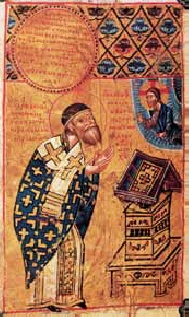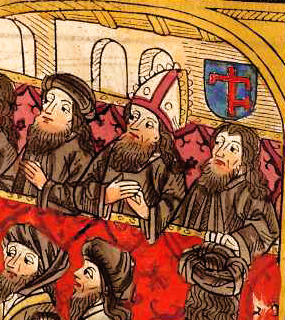|
Anonymous Athonite
Anonymous Athonite (also known in Serbia as Nepoznati Svetogorac; late 14th to mid-15th century) was Isaija the Monk's biographer and one of the many unidentified authors of Medieval works. It is assumed that he wrote "The Life of the Elder Isaiah" (Isaija) in the Russian monastery of St. Panteleimon Monastery on the Holy Mountain ( Mount Athos), shortly after the death of Isaiah, since he was well acquainted with various moments of the youth and monastic life of Isaiah, being his contemporary and perhaps his colleague or disciple as well. The text is known from a transcript from the 15th century, located at Hilandar Monastery. Another work is attributed to him, the translation of the Books of Kings, in 1415. See also *Lazarević dynasty * Battle of Kosovo * Jefimija * Princess Milica of Serbia * Stefan Lazarević * Teodosije * Danilo II, Serbian Archbishop * Stefan Dušan * Elder Siluan * Teodosije the Hilandarian (1246-1328), one of the most important Serbian writers in the Midd ... [...More Info...] [...Related Items...] OR: [Wikipedia] [Google] [Baidu] |
Isaija The Monk
Isaija the Monk ( sr, Инок Исаија or in English: Inok Isaija; ca. 1300–after 1375), also known as Elder Isaija (Elder Isaiah) () and Isaija of Serres (Elder Isaiah of Serres) (), was a 14th-century Serbian monk, one of many Serbian monk-scribes in the Middle Ages who translated ancient Greek manuscripts into the Serbian recension of Old Church Slavonic. His major work is the translation of the works of Pseudo-Dionysius the Areopagite from Byzantine Greek. Isaija's commentaries on political events occur in the context of the fall of the Serbian principality of Serres in 1371, which led the descendants of these local governors to accept Ottoman suzerainty. As a young boy, Isaija joined the monastic life of the Serbian Orthodox Church affiliated to St. Joachim of Osogovo Monastery on Osogovo Mountain in northern Macedonia, and then to Hilandar Monastery on Mount Athos in Greece, where he spent the rest of his life. In Hilandar, he worked as a translator and became very ... [...More Info...] [...Related Items...] OR: [Wikipedia] [Google] [Baidu] |
Pachomius The Serb
Pachomius the Serb (russian: Пахомий Серб, sr, Пахомије Србин), also known as Pachomius Logothetes, russian: Пахомий Логофет, el, Παχώμιος Λογοθέτης) was a 15th-century Serbian hagiographer who, after taking monastic vows, was schooled on Mount Athos and mastered the ornate style of medieval Serbian literature.G. M. Prokhorov, “Pakhomii Serb,” in D. S. Likhachev, ''Slovar’ knizhnikov i knizhnosti Drevnei Rusi'', vol. 2, Pervaia polovina XIV-XVI v., pt. 2. He is credited by the Russian Early Texts Society for the Serbian version of Barlaam and Josaphat from Old Greek. In the 1450s and 1460s he resided at the Trinity Monastery of St. Sergius north of Moscow. One of his major undertakings was a Russian translation of the New Testament. In about 1470 Archbishop Jonas (Iona) asked him to settle in Novgorod where he prepared a set of the lives of local saints. It has been suggested that ''The Tale of the Princes of Vladimir ... [...More Info...] [...Related Items...] OR: [Wikipedia] [Google] [Baidu] |
Danilo III (patriarch)
Danilo III ( sr-cyr, Данило III; also called Danilo the Younger, 1350–1400) was the fifth Patriarch of the Serbian Orthodox Church (1390–1396), a writer and poet, known also for transferring the relics of Lazar of Serbia from the church of Sveti Spas (Holy Saviour) in Priština to Ravanica in 1391. Biography He was a high official of the Serbian Orthodox Church. In 1382, Danilo was the abbot of Drenča Monastery, and from 1390, he replaced Jefrem as Serbian Patriarch. As a retrospective writer, he distinguished himself by including in his works concrete details, dramatic scenes, and dialogues. Danilo III is the author of ''The Office for Saint Sava'', ''The Office for St. Simeon'', ''The Office for St. Milutin'', and the "Narration about Prince Lazar." There are, however, a few literary historian skeptics who question Danilo's authorship of his "Narration" and ascribe it to some anonymous monk from Ravanica Monastery. The "Narration" was written shortly after the Battle ... [...More Info...] [...Related Items...] OR: [Wikipedia] [Google] [Baidu] |
Grigorije Vasilije
Monk Grigorije also known as Grigorije Vasilije ( sr-Cyrl, Григорије Василије; c. 1550 - after 1598) was tonsured into the Great Schema in the Tower of Saint Sava at Karyes, Mount Athos, where he got his second name Vasilije. We have known him from a colophon in the Serbian recension of the Slavonic Josephus, "The History of the Jewish War". He transcribed and translated the Slavonic Josephus into Serbian vernacular at Karyes, the administrative center of Mount Athos, in 1585. In addition, the Hilandar Monastery has preserved five petitions that hieromonk Grigorije in his frequent travels throughout Europe delivered to nobleman Nikita Romanov (the grandfather of the future tsar Michael of Russia) in April 1586; Andrej Jakovlević (two petitions written before 1582); Polish king Stephen Bathory; and Duke Andrey Kurbsky. Also, these documents have been published by the Moscow Main Archive of the Ministry of Foreign Relations. According to records Grigorije Vasili ... [...More Info...] [...Related Items...] OR: [Wikipedia] [Google] [Baidu] |
Marko Pećki
Marko Pećki (village of Ljevoši, near Peć in Kosovo, Serbia, 1360 – Ljevoši, Kosovo, Serbia, after 1411) was a Serbian medieval writer and poet who lived at the time of Prince Lazar of Serbia and Stefan Lazarević. He is best known for the "Life of the Serbian Patriarch Ephraim" and other biographies. Biography Bishop Mark of Peć (hence Marko Pećki) belongs to a prominent place in the hesychast monastic hagiography from the time of Prince Lazar of Serbia and the Battle of Kosovo in 1389. He left his autobiographical data in his Letter to commemorate Gerasim and Euphemia (Jefimija). Marko was born in 1360 in a village near Peć in Serbian Kosovo, as the youngest of four sons, born into a priestly family. We do not know his baptismal name, however, we know that all four brothers were priests. His father's secular name was probably George because he chose Gerasim as his new name for his new monastic way of life, and as Hieromonk Gerasim, he went on to build the church of St. ... [...More Info...] [...Related Items...] OR: [Wikipedia] [Google] [Baidu] |
Romylos Of Vidin
Romylos of Vidin also known as Romylos of Ravanica or Romylus the Athonite (''Romil Svetogorac'', ''Romil Svetogorski''); ( bg, Ромил Бдински; sr, Ромил Раванички) was a 14th-century Bulgarian cleric, a disciple of Gregory of Sinai. He is also known as the teacher of Grigorije of Gornjak. He is regarded as part of both Bulgarian and Serbian literature. Biography He was born in Vidin, Tsardom of Vidin c. 1330 and died in the Ravanica Monastery, Serbia c. 1385. Romylos was among the brightest followers of the Hesychast tradition in the Eastern Orthodox Church in the 14th century. In the wake of the Ottoman conquest of Bulgaria Romylos was among the many Bulgarian intellectuals who emigrated to neighbouring Orthodox countries and brought their talents and texts. His tomb is in the church narthex of the Monastery of Ravanica, Serbian Despotate. Life He was born in the first quarter of the fourteenth century in the "valiant and glorious city Vidin", north ... [...More Info...] [...Related Items...] OR: [Wikipedia] [Google] [Baidu] |
Jakov Of Serres
Jakov of Serres ( sr, Јаков Серски; 1300–1365) was a medieval Serbian writer, scholar, translator, and hierarch of the Serbian Orthodox Church, one of the most important men of letters working in the 14th century. Biography Evidence about his life is scarce, but his literary legacy suggests an excellent knowledge of Greek and Slavic languages. In 1343, King (and eventually Emperor) Stefan Dušan began to build the Monastery of the Holy Archangels near Prizren; he appointed Jakov, a learned and highly esteemed monk, its first ''hegumen'' (abbot). Both Stefan Dušan and his wife Jelena were in awe of Jakov's wide knowledge and they often sought his company and counsel. In 1345, Stefan Dušan captured the city of Serres from the Byzantine Empire; and Jakov was appointed Metropolitan of Serres and its surrounding territories. The population of Serres was mixed Slavic, Albanian and Greek and Jakov was fluent in all three languages and their dialects. In fact, Jakov wrote so ... [...More Info...] [...Related Items...] OR: [Wikipedia] [Google] [Baidu] |
Rajčin Sudić
Rajčin Sudić (c. 1335-after 1360) was a Serbian monk- scribe who lived and worked during the time of Lord Vojihna, the father of Jefimija. From the inscription Rajčin Sudić left in the margin of the Chronicles written in the 14th Century, we know that he was a prisoner of some feudal ruler of that period. There is some evidence that this ruler was Vojihna because at the time he possessed many fiefs. It is possible that Sudić was a scapegoat of a vehement opponent of "clan government". That is usurpation of administrative posts by men of two, three and more fiefs, an abuse which threatened to follow the overthrow of Vojihna—he must have been accused by someone that Sudić allegedly conspired to assist Vojihna's enemies and was imprisoned for five months, along with another "accomplice" by the name of Kijevac. While in prison he wrote in "An Inscription": The probable date of the inscription is the year 1360. The manuscript in which that inscription was included was burnt ... [...More Info...] [...Related Items...] OR: [Wikipedia] [Google] [Baidu] |
Radoslav's Gospel
Radoslav's Gospel (also known as ''Leningrad Serbian Gospel'', ''Gospel of the Spiritual Visarion'', and ''Tetraevangelion of Inok from Dalša'') was created in 1429 by miniaturist Radoslav and celibate priest Feodor, a Serbian monk-scribe from Dalša. It contains a number of miniatures, including " An Evangelist Portrait". The gospels are in the Russian National Library, St. Petersburg. In 2001 it was republished by the National Library of Serbia and the Central Bank of Yugoslavia as part of the Svetilnik series. See also *List of medieval Serbian literature Medieval Serbian literature or Old Serbian literature ( sr, Стара српска књижевност) refers to the literature written in medieval forms of Serbian language, up to the end of the 15th century, with its traditions extending in ... References 1429 books Gospel Books 15th-century biblical manuscripts Serbian books Serbian manuscripts 15th-century illuminated manuscripts Cyrillic manuscripts ... [...More Info...] [...Related Items...] OR: [Wikipedia] [Google] [Baidu] |
Grigorije Of Gornjak
Grigorije of Gornjak ( sr, Григорије Горњачки, Григорије из Горњака; 1375–1379), also known as Grigorije the Younger () and Grigorije the Silent (), was Serbian Orthodox monk who was canonized as saint. He studied at Mount Sinai with his teachers were Gregory of Sinai and Romylos of Vidin. Together with a group of Serbian, Bulgarian and Greek monks, Grigorije returned to Moravian Serbia between 1375 and 1379. They established a strong hesychastic colony led by Grigorije. Their patron was Prince Lazar who built the Gornjak monastery for their colony. He endowed it to Grigorije and his fellow monks by written chapter, confirmed by the Serbian patriarch on 17 May 1379. Grigorije spent the rest of his life at the monastery. Early life Grigorije, a Serb, moved from Constantinople to Paroria, a famous monastic colony in Thrace. There he met Roman and his friend Ilarion, former students of Gregory of Sinai. Romil moved from other monks in a separate ... [...More Info...] [...Related Items...] OR: [Wikipedia] [Google] [Baidu] |
Gregory Tsamblak
Gregory Tsamblak or Grigorij Camblak ( bg, Григорий Цамблак, sr-Cyr, Григорије Цамблак; c. 1365–1420) was a Bulgarian writer and cleric. He was the pretended Metropolitan of Lithuania between 1413 and 1420. A Bulgarian noble, Tsamblak lived and worked in Bulgaria, but also in Medieval Serbia and Kievan Rus'. His literary works represent a heritage of the national literature of Serbia, particularly the style of Old Serbian ''Vita'' made popular in the monasteries of the 12th century. Life He was born in Tarnovo, the capital of the Second Bulgarian Empire, the son of a rich family. His cousin was Cyprian, Metropolitan of Kiev. Tsamblak was a disciple of the prominent Bulgarian hesychast writer Patriarch Evtimiy of Bulgaria. Bulgaria fell under Ottoman domination following the Bulgarian-Ottoman Wars. Following this, he emigrated first to Constantinople, then became presbyter of the Church of Wallachia and Moldavia. He then went to Serbia where he wa ... [...More Info...] [...Related Items...] OR: [Wikipedia] [Google] [Baidu] |
Cyprian, Metropolitan Of Kiev
Cyprian ( bg, Киприан, russian: Киприан, be, Кіпрыян, uk, Кипріан) (c. 1336 – 16 September 1406) was the Metropolitan of Kiev, Russia and Lithuania (2 December 1375–12 February 1376) and the Metropolitan of Kyiv and All Rus' (12 February 1376–16 September 1406) in the Ecumenical Patriarchate of Constantinople. During both periods, he was opposed by rival hierarchs and by the Grand Prince of Moscow. He was known as a bright opinion writer, editor, translator, and book copyist.Shabuldo, F. Cyprian (КИПРІЯН)'. Encyclopedia of History of Ukraine. 2007 He is commemorated by the Russian Orthodox Church on May 27 and September 16 (by the Old style). Early life Cyprian was a clergyman of Bulgarian origin. He is supposed to have been born in aristocratic family of Tsamblak from the capital Tarnovo. After his upbringing, education, and worldview, he was a hesychast. As a young man Cyprian studied at Kilifarevo, just south of Tarnovo, where ... [...More Info...] [...Related Items...] OR: [Wikipedia] [Google] [Baidu] |




